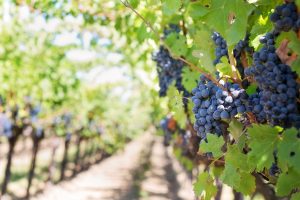 “When the grapes are out, we are out,” said Violeta Tsolova, professor and director of the Center for Viticulture and Small Fruit Research at Florida Agricultural and Mechanical University (FAMU). She was referring to the researchers and students at the center working to help grape growers be successful in the Southeast viticulture industry.
“When the grapes are out, we are out,” said Violeta Tsolova, professor and director of the Center for Viticulture and Small Fruit Research at Florida Agricultural and Mechanical University (FAMU). She was referring to the researchers and students at the center working to help grape growers be successful in the Southeast viticulture industry.
NATIVE GRAPES
Growers in the Southeast have the ability to grow muscadine, a grape that is native to the United States.
Frank Humphries, an enology research associate at the center, said, “I feel like the Southeast … has a niche in the opportunity to grow muscadines, and I believe growers should take full advantage of that.”
Humphries said these grapes have unique qualities, including health benefits, which give growers a valuable marketing tool for muscadines.
Muscadine grapes can tolerate Pierce’s disease (PD), a bacterial disease that invades and eventually kills the non-native European grape varieties. This tolerance makes it easier for Southeast growers to produce the native grapes.
BREEDING
Tsolova said in addition to the growth of muscadines, growers are interested in producing European variety grapes for the traits that are successful in the market, such as flavor and size. These varieties, however, are highly susceptible to PD. Therefore, the center’s breeding program works to create new varieties that have the traits growers want in addition to the PD resistance.
Other U.S. universities have been testing these varieties as well. Tsolova said while these varieties did grow and survive in the Southeast, there was still a high level of disease pressure that reduces the quality of the grapes. While PD is the main disease, there are other fungal pathogens and diseases that cause issues for growers.
In addition to traditional breeding methods, FAMU is working to sequence the entire genome of the muscadine grape. This would make breeding easier and more efficient by allowing researchers to “mark” a specific trait and come back to it in the new breeding selections. Examples of these traits are the color or size and shape of the fruit. Tsolova said researchers have the initial version of the genome sequence completed and are working to create a second, improved version.
OUTREACH
According to Tsolova, the center was opened in 1978 to create possibilities for growers who wanted to be a part of the viticulture industry in the Southeast.
Projects and programs from the center allow researchers to accumulate information and share it with growers. Many Florida vineyards are small in size and may not have access to the same information that large producers in other parts of the world may have. To fix this, an online database is being created at the center to provide information on topics such as vinification and healthy qualities of the commercial muscadine grape varieties. This database will provide growers with information on issues they may face when it comes to grape and wine production.
The center provides growers with information and resources to help them be successful in the viticulture industry, fulfilling the mission and the original purpose for opening the center 40 years ago.
Share this Post









